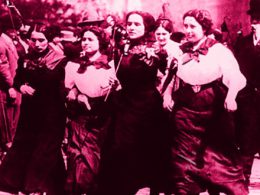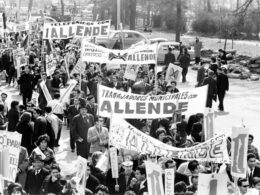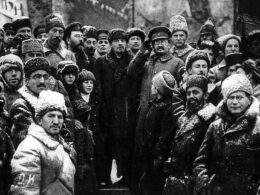By Summer Conneely
From the origin of the phrase “Bread and Roses” in a speech by suffragette Helen Todd in 1911, to a poem by James Oppenheim inspired by the speech, to the setting of the poem to music by Mimi Fariña, the power of idea of Bread and Roses has shone through for over a century. Appearing on countless picket lines, feminist rallies and festivals, in the 2014 movie Pride and beyond, it remains an important call for the workers’ movement.
The central meaning of Bread and Roses can be seen simply in the poem’s line, “Yes, it is Bread we fight for, but we fight for Roses, too,” emphasising that we do demand the basic necessities of life, but that alone is not enough. We also demand dignity, respect, and the full enjoyment and fulfilment of life beyond that. With that meaning all too relevant today, it’s worth looking at the event most commonly associated with the phrase: the 1912 Lawrence Textile Strike, often referred to as the ‘Bread and Roses Strike’.
Gruelling exploitation
The American Woolen Co. mill in Lawrence, Massachusetts, was a gruelling place for its workforce. With most workers being immigrant women and almost half being girls between the ages of 14 and 18, the town of Lawrence had the fifth-highest child mortality rate in the US, with one-third of workers dying before reaching 25. Additionally, the workers were completely divided along ethnic lines by the bosses. With the imposition of a reduction in hours and pay, the already struggling workers faced an intolerable reduction in living standards. Upon finding out about the pay cut, a large group of Polish women workers walked out, quickly uniting the rest of the workforce, and later, with the help of organised trade unions, a strike committee was formed.
Unfortunately, the United Textile Workers, a trade union to which most of the workers were affiliated, did not support the actions of the workers. Instead, the leadership fell to the Industrial Workers of the World (IWW), a militant labour union that sought to organise all workers in “One Big Union”, regardless of their background. The IWW helped the workers put forward their demands: a 15% wage increase for a 54-hour work week, double pay for overtime work, and no discrimination against workers for their strike action. In response to the 27,000-strong strike the city and state government collaborated with the mill owners to try to crush the workers.
Violence against strikers
The ruling class resorted to more desperate and violent measures as support grew for the strikers. The Mayor of Lawrence ordered the city militia onto the streets, the Governor of Massachusetts brought out the state police, the mill owners used fire hoses on the picketers, and all those who defended themselves were imprisoned. In total, three people were murdered in retaliation for the strike action. Additionally, there were attempts to frame the strike leaders for the murder of a young striker, and later, on the orders of the mill owners, bombs were planted in another attempt to frame the strikers.
Despite the violence, intimidation and repression, the workers continued their struggle and wouldn’t submit. In fact, in many cases, the repression only strengthened their solidarity with each other, and strengthened the solidarity that working-class people from across the US showed towards them. Their community had set up soup kitchens and food distribution networks for the strikers, medical care was provided by volunteering doctors, and funds were raised across the US by ordinary working-class people who wanted to show support to their fellow workers. The unshakeable resolve of the workers’ solidarity forced the bosses into conceding on many issues. While they didn’t have all of their demands met, their actions represented a victory, not just for themselves, but for the working class in general, with a raising of conditions across the US textile industry.
As the US continued on its path to becoming the centre of global capitalism, only increasing its opposition to workers’ struggles, the Bread and Roses strike remained an incredible inspiration in the midst of this. It represented the embodiment of solidarity and struggle against intolerable capitalist exploitation. One element that shines through for today is just how important it is to stand behind the most oppressed elements of the working class, and not to shy away from tackling all forms of oppression.
Organising migrant and women workers
In fact, a reason that the more conservative elements of the trade union movement didn’t support the Lawrence Textile Strike was partly due to their belief that a workforce made up almost entirely of immigrants and women could not be effectively organised. Unfortunately, this attitude still persists today, albeit put in less crude terms or dressed up in leftist-sounding rhetoric. With migrant and women workers often treated as the ‘most exploitable’ groups of workers by the ruling class, showing solidarity is even more vital – primarily to show support for some of the vulnerable workers, but because their fight and their victory will raise conditions for all workers.
The Bread and Roses strike demonstrates the struggle not just for economic improvements but on a more fundamental level, a struggle for dignity, for workers to be treated as human. Indeed, at the heart of so many struggles is the desire to be treated as a human being, that nobody can use their power over you, oppress you, treat you as if you are less than them. This is a central tenet of struggles for workers’ rights, feminist movements, trans rights, struggles for racial equality, disability rights, migrant rights and many other struggles. So when we say Bread and Roses, that is what we struggle for, and that is the spirit we’re drawing from.












